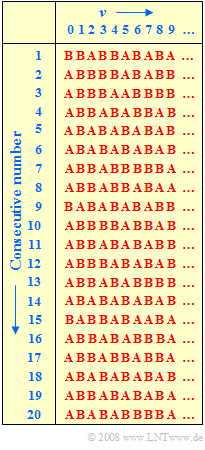Exercise 1.6: Transition Probabilities
On the right you see $20$ realizations of a binary homogeneous Markov chain of first order with the events $A$ and $B$:
- One can already see from this representation that at the beginning $(ν = 0)$ event $A$ predominates.
- However, at later times, approximately from $ν = 4$: The event $B$ occurs somewhat more frequently.
By averaging over millions of realizations, some event probabilities were determined numerically:
- $${\rm Pr}(A_{\nu \hspace{0.05cm} = \hspace{0.05cm}0}) \approx 0.9, \hspace{0.3cm}{\rm Pr}(A_{\nu \hspace{0.05cm} = \hspace{0.05cm}1}) \approx 0.15, \hspace{0.3cm} {\rm Pr}(A_{\nu \hspace{0.05cm} > \hspace{0.05cm}4}) \approx 0.4.$$
These empirical numerical values will be used to determine (approximately) the "transition probabilities" of the Markov chain.
Hints:
- The exercise belongs to the chapter Markov Chains.
- You can check your results with the (German language) interactive SWF applet
- Ereigniswahrscheinlichkeiten einer Markov-Kette erster Ordnung ⇒ "Event Probabilities of a First Order Markov Chain".
Questions
Solution
- $${\rm Pr}(A_{\nu=0}) = 17/20 \;\underline{= 0.85}, \hspace{0.2cm} {\rm Pr}(A_{\nu=1}) = 2/20 \;\underline{= 0.10}, \hspace{0.2cm} {\rm Pr}(A_{\nu=9}) = 8/20 \;\underline{= 0.40}.$$
(2) Proposed solutions 1 and 2 are correct:
- $A$ is followed by $B$ much more frequently than by $A$, that is, it will certainly be ${\rm Pr}(B \hspace{0.05cm} | \hspace{0.05cm}A) > {\rm Pr}(A \hspace{0.05cm} | \hspace{0.05cm}A)$.
- All four transitions between the two events $A$ and $B$ are possible. It follows that all four transition probabilities will be nonzero.
- Because of ${\rm Pr}(B_\text{v=0}) \ne 0$ and ${\rm Pr}(B \hspace{0.05cm} | \hspace{0.05cm}B) \ne 0$, the sequence "$B\hspace{-0.05cm}-\hspace{-0.05cm}B \hspace{-0.05cm}-\hspace{-0.05cm}B\hspace{-0.05cm}-\hspace{-0.05cm}B\hspace{-0.05cm}-\hspace{0.15cm}...$" can of course also be generated, even though it is not present in the twenty Markov chains output here.
(3) For a first-order Markov chain, with the abbreviations ${\rm Pr}(A_0) = {\rm Pr}(A_{\nu=0})$ and ${\rm Pr}(A_1) = {\rm Pr}(A_{\nu=1})$:
- $${\rm Pr}(A_1) = {\rm Pr}(A \hspace{0.05cm} | \hspace{0.05cm} A) \cdot {\rm Pr}(A_0) \hspace{0.1cm} + \hspace{0.1cm} {\rm Pr}(A \hspace{0.05cm} | \hspace{0.05cm} B) \cdot {\rm Pr}(B_0).$$
- The ergodic probabilities are ${\rm Pr}(A) = {\rm Pr}(A_{\nu \hspace{0.05cm} > \hspace{0.05cm}4}) = 0.4$ and ${\rm Pr}(B) = {\rm Pr}(B_{\nu \hspace{0.05cm} > \hspace{0.05cm}4}) = 0.6$. The following relationship exists between these:
- $${\rm Pr}(A) = {\rm Pr}(A \hspace{0.05cm} | \hspace{0.05cm} A) \cdot {\rm Pr}(A) \hspace{0.1cm} + \hspace{0.1cm} {\rm Pr}(A \hspace{0.05cm} | \hspace{0.05cm} B) \cdot {\rm Pr}(B).$$
- With the numerical values given, we obtain from these last two equations:
- $$0.15 = {\rm Pr}(A \hspace{0.05cm} | \hspace{0.05cm} A) \cdot 0.90 \hspace{0.1cm} + \hspace{0.1cm} {\rm Pr}(A \hspace{0.05cm} | \hspace{0.05cm} B) \cdot 0.10 ,$$
- $$0.40 = {\rm Pr}(A \hspace{0.05cm} | \hspace{0.05cm} A) \cdot 0.40 \hspace{0.1cm} + \hspace{0.1cm} {\rm Pr}(A \hspace{0.05cm} | \hspace{0.05cm} B) \cdot 0.60 .$$
- Multiplying the first equation by $6$ and subtracting the second from it gives:
- $$0.5 = 5 \cdot {\rm Pr}(A \hspace{0.05cm} | \hspace{0.05cm} A) \hspace{0.15cm} \Rightarrow \hspace{0.15cm} {\rm Pr}(A \hspace{0.05cm} | \hspace{0.05cm} A) \hspace{0.15cm}\underline {= 0.1}.$$
- Substituting this result into one of the upper equations, we get $ {\rm Pr}(A\hspace{0.05cm}|\hspace{0.05cm}B) = 0.6$. The other probabilities are:
- $${\rm Pr}(B\hspace{0.05cm}|\hspace{0.05cm}A) = 1 - {\rm Pr}(A\hspace{0.05cm}|\hspace{0.05cm}A) = 0.9, \hspace{0.3cm} {\rm Pr}(B\hspace{0.05cm}|\hspace{0.05cm}B) = 1 - {\rm Pr}(A\hspace{0.05cm}|\hspace{0.05cm}B)\ \underline{= 0.4}.$$
(4) This case is only possible if the Markov chain starts with $B$ and then there are nine transitions from $B$ to $B$ :
- $${\rm Pr}(B_0,\hspace{0.05cm}\text{...} \hspace{0.05cm}, B_{9}) = {\rm Pr}(B_0) \cdot {\rm Pr}(B\hspace{0.05cm}| \hspace{0.05cm} B)^9 = {\rm 0.1} \cdot {\rm 0.4}^9 \hspace{0.15cm}\underline {\approx 2.62 \cdot 10^{-5}}. $$
(5) Here we have to assume the ergodic probability ${\rm Pr}(A)$ and we obtain:
- $${\rm Pr}(A_{\nu}, \hspace{0.05cm}B_{\nu +1}, \hspace{0.05cm}B_{\nu +2},\hspace{0.05cm} A_{\nu +3}) = {\rm Pr}(A) \hspace{0.01cm}\cdot \hspace{0.01cm}{\rm Pr}(B\hspace{0.05cm}| \hspace{0.05cm} A) \hspace{0.01cm}\cdot\hspace{0.01cm} {\rm Pr}(B\hspace{0.05cm}| \hspace{0.05cm} B)\hspace{0.01cm}\cdot \hspace{0.01cm}{\rm Pr}(A\hspace{0.05cm}| \hspace{0.05cm} B)\hspace{0.15cm}\underline {\approx 8.64 \% }.$$
